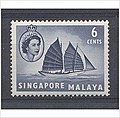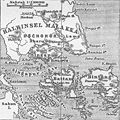Portal:Singapore
 Map of Singapore Singapore, officially the Republic of Singapore, is an island country and city-state in Southeast Asia. The country's territory comprises one main island, 63 satellite islands and islets, and one outlying islet. It is about one degree of latitude (137 kilometres or 85 miles) north of the equator, off the southern tip of the Malay Peninsula, bordering the Strait of Malacca to the west, the Singapore Strait to the south along with the Riau Islands in Indonesia, the South China Sea to the east, and the Straits of Johor along with the State of Johor in Malaysia to the north.
Singapore's history dates back at least eight hundred years, having been a maritime emporium known as Temasek and subsequently a major constituent part of several successive thalassocratic empires. Its contemporary era began in 1819, when Stamford Raffles established Singapore as an entrepôt trading post of the British Empire. In 1867, Singapore came under the direct control of Britain as part of the Straits Settlements. During World War II, Singapore was occupied by Japan in 1942 and returned to British control as a separate Crown colony following Japan's surrender in 1945. Singapore gained self-governance in 1959 and, in 1963, became part of the new federation of Malaysia, alongside Malaya, North Borneo, and Sarawak. Ideological differences led to Singapore's expulsion from the federation two years later; Singapore became an independent sovereign country in 1965. After early years of turbulence and despite lacking natural resources and a hinterland, the nation rapidly developed to become one of the Four Asian Tigers. As a highly developed country, it has one of the highest GDP per capita (PPP) in the world. It is also identified as a tax haven. Singapore is the only country in Asia with a AAA sovereign credit rating from all major rating agencies. It is a major aviation, financial, and maritime shipping hub and has consistently been ranked as one of the most expensive cities to live in for expatriates and foreign workers. Singapore ranks highly in key social indicators: education, healthcare, quality of life, personal safety, infrastructure, and housing, with a home-ownership rate of 88 percent. Singaporeans enjoy one of the longest life expectancies, fastest Internet connection speeds, lowest infant mortality rates, and lowest levels of corruption in the world. It has the third highest population density of any country in the world, although there are numerous green and recreational spaces as a result of urban planning. With a multicultural population and in recognition of the cultural identities of the major ethnic groups within the nation, Singapore has four official languages: English, Malay, Mandarin, and Tamil. English is the common language, with exclusive use in numerous public services. Multi-racialism is enshrined in the constitution and continues to shape national policies in education, housing, and politics. Singapore is a parliamentary republic in the Westminster tradition of unicameral parliamentary government, and its legal system is based on common law. While the country is de jure a multi-party democracy with free elections, the government under the People's Action Party (PAP) wields widespread control and political dominance. The PAP has governed the country continuously since full internal self-government was achieved in 1959, and holds a supermajority in Parliament. One of the five founding members of ASEAN, Singapore is also the headquarters of the Asia-Pacific Economic Cooperation Secretariat, the Pacific Economic Cooperation Council Secretariat, and is the host city of many international conferences and events. Singapore is also a member of the United Nations, the World Trade Organization, the East Asia Summit, the Non-Aligned Movement, and the Commonwealth of Nations. (Full article...)Selected article -The history of the modern state of Singapore dates back to its founding in the early 19th century; however, evidence suggests that a significant trading settlement existed on the island in the 14th century. The last ruler of the Kingdom of Singapura, Parameswara, was expelled by the Majapahit or the Siamese before he founded Malacca. Singapore then came under the Malacca Sultanate and subsequently the Johor Sultanate. In 1819, British statesman Stamford Raffles negotiated a treaty whereby Johor would allow the British to locate a trading port on the island, ultimately leading to the establishment of the Crown colony of Singapore in 1867. Important reasons for the rise of Singapore were its nodal position at the tip of the Malay Peninsula flanked by the Pacific and Indian Oceans, the presence of a natural sheltered harbour, as well as its status as a free port. During World War II, Singapore was invaded and occupied by the Japanese Empire from 1942 to 1945. When the Japanese surrendered, Singapore reverted to British control, with increasing levels of self-government being granted, resulting in Singapore's merger with the Federation of Malaya to form Malaysia in 1963. However, social unrest, racial tensions, and political differences between Singapore's governing People's Action Party (PAP) and Malaysia's Alliance Party resulted in Singapore's expulsion from Malaysia. Singapore became an independent republic on 9 August 1965. By the 1990s, the country had become one of the world's most prosperous nations, with a highly developed free market economy and strong international trading links. It now has the highest per capita gross domestic product in Asia, which is 7th in the world, and it is ranked 9th on the UN Human Development Index. (Full article...) Selected picture Resorts World Sentosa, one of the two Integrated Resorts in Singapore. This view is from the Tiger Sky Tower. Read more... General imagesThe following are images from various Singapore-related articles on Wikipedia.
Selected biography -Rex Anthony Shelley (27 October 1930 – 21 August 2009) was a Singaporean author. A graduate of the University of Malaya in Malaysia and Cambridge trained in engineering and economics, Shelley managed his own business and also worked as member of the Public Service Commission (PSC) for over 30 years. For his service, he was conferred the Bintang Bakti Masyarakat (Public Service Star) by the Government of Singapore in 1978, and an additional Bar the next year. Shelley started writing fiction late in life, publishing his first novel, The Shrimp People, in 1991 at the age of sixty one. The first substantial work by a Singaporean writer about the Eurasian community in Singapore, it was highly commended by The Straits Times and won the 1992 National Book Development Council of Singapore (NBDCS) Award. The books People of the Pear Tree (1993), Island in the Centre (1995) and A River of Roses (1998), on the same theme, followed within a decade; respectively, they won NBDCS Highly Commended Awards in 1994 and 1996, and the Dymocks Singapore Literature Prize in 2000. In 2007 he was the Singaporean winner of the S.E.A. Write Award. Critics have responded positively to his writing, noting its "passionate, humane" style, and observing how his breadth of life experience gave rise to a talent for characterisation plus an ability to blend "a sharp sense of observed commentary with historical detail". (Full article...) Did you know (auto-generated)
In this month
More did you know -
Selected panoramaVivoCity (Chinese: 怡丰城) is the largest shopping mall in Singapore, located at the HarbourFront precinct . Opened on 7 October 2006, it marked the completion of the main structure by a topping-out ceremony on 18 April 2006 and was officially opened on December 1, 2006. Singapore topicsRelated portalsSoutheast Asia Other Countries Tasks
CategoriesWikiprojectsAssociated WikimediaThe following Wikimedia Foundation sister projects provide more on this subject:
Discover Wikipedia using portals |






























































